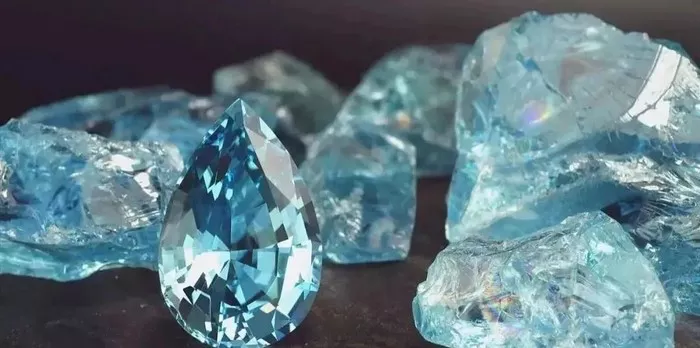Aquamarine, with its serene blue and green hues, has captivated humans for centuries. This gemstone, a member of the beryl family, is cherished for its beauty and allure. But how does this precious stone come into existence, where is it found, how is it mined, and what factors contribute to its value? Let’s delve deep into the world of aquamarine to uncover the answers.
Formation of Aquamarine
Aquamarine, like many gemstones, has a remarkable origin story rooted in geological processes spanning millions of years. Its formation begins deep within the Earth’s crust, where molten rock, known as magma, undergoes a gradual cooling and solidification process. Within this molten brew, minerals such as beryl, a silicate mineral, are present, awaiting their transformation into the coveted aquamarine.
As the magma cools over vast stretches of time, the beryl crystals begin to form, incorporating elements like aluminum, beryllium, silicon, and oxygen into their crystalline structure. It is during this transformative phase that trace amounts of iron infiltrate the crystal lattice, imparting the characteristic blue and green hues that define aquamarine’s allure.
The slow cooling process and the chemical interplay between elements within the magma give rise to aquamarine crystals of varying sizes and qualities. Some crystals grow to impressive dimensions, while others remain smaller but no less exquisite.
Geological Occurrence
Aquamarine manifests in various geological settings, each contributing to its diversity in occurrence:
Granite Pegmatite Rocks: Aquamarine predominantly forms within granite pegmatite rocks. These rocks, characterized by their coarse-grained structure, provide the ideal conditions for the crystallization of beryl and the subsequent formation of aquamarine.
Hydrothermal Carbonate Veins and Cavities: Hydrothermal processes alter the composition of granitic rocks, leading to the formation of aquamarine within carbonate veins and cavities. These geological phenomena contribute to the enrichment of aquamarine deposits in certain regions.
Gem-Gravel Placer (Alluvial) Deposits: Aquamarine, along with other beryls, can also be found in gem-gravel placer deposits. These deposits result from the erosion and weathering of primary sources, leading to the accumulation of gemstones in riverbeds and sedimentary layers.
Specific locations around the globe boast significant aquamarine deposits, including Pakistan, Brazil, the Ural Mountains in Russia, China, California, Colorado (United States), Myanmar, Ukraine, and various regions in Africa.
Mining Methods
The extraction of aquamarine relies on several mining techniques tailored to the geological context:
Open-Pit Mining: This method involves the excavation of surface-level deposits through the removal of overlying soil and rock. Open-pit mining is commonly employed in regions where aquamarine occurs near the surface, allowing for efficient extraction.
Underground Mining: In instances where aquamarine deposits lie beneath the Earth’s surface, underground mining may be necessary. This technique involves the construction of tunnels and shafts to access the gemstone reserves hidden beneath layers of rock.
Aquamarine’s status as a relatively common gemstone within the beryl family makes it more accessible for mining and purchase compared to rarer counterparts.
Processing and Refinement
Once the aquamarine-bearing ore is extracted from the Earth, it undergoes a series of processing steps to transform it into polished gemstones. The first stage of processing involves crushing and grinding the raw ore to reduce it to manageable sizes. This crushed ore is then subjected to gravity separation techniques to separate the aquamarine crystals from the surrounding rock and minerals.
Next, the extracted aquamarine crystals undergo sorting and grading based on factors such as color, clarity, size, and shape. Skilled gemologists carefully examine each crystal, categorizing them according to quality standards established by the gemstone industry. High-quality aquamarine crystals are selected for faceting, while lower-grade material may be used for cabochons or beads.
Faceting, the art of cutting and polishing gemstones to enhance their brilliance and sparkle, is a precise and labor-intensive process. Master lapidaries use specialized equipment such as diamond saws and polishing wheels to create facets on the surface of the aquamarine crystals. Each facet is carefully angled to optimize the gemstone’s light reflection and refraction properties, resulting in a dazzling display of color and radiance.
Value Determinants
Several factors influence the value of aquamarine, with each aspect contributing to its desirability and market worth:
Weight: Aquamarine, like other gemstones, is priced based on its weight, measured in carats. Larger stones typically command higher prices, reflecting their rarity and aesthetic appeal.
Color: The color of aquamarine is a significant determinant of its value. Stones with intense blue and green hues are highly sought after, while lighter shades may be less valuable. Exceptional clarity and saturation contribute to the gem’s allure and value.
Cut: The cut of an aquamarine gemstone plays a crucial role in enhancing its brilliance and maximizing its visual impact. Skilled lapidaries meticulously shape each stone to accentuate its natural beauty while optimizing light reflection and refraction.
Clarity: The clarity of aquamarine refers to the absence of internal inclusions and blemishes. Stones with high clarity and transparency are prized for their purity and visual appeal.
Transparency and overall physical appearance also play significant roles in determining the value of aquamarine, with flawless specimens commanding premium prices in the gemstone market.
Conclusion
Aquamarine’s journey from deep within the Earth to the surface, its diverse geological occurrences, mining methods, and value determinants highlight the intricate processes and factors that shape its significance in the world of gemstones. As a symbol of purity, tranquility, and elegance, aquamarine continues to captivate gem enthusiasts and collectors alike, perpetuating its timeless allure across generations.


